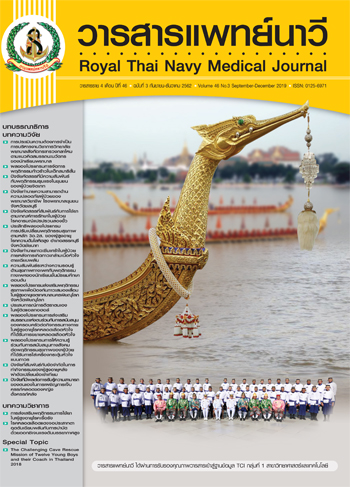การประเมินความต้องการจำเป็นการบริหารงานวิชาการวิทยาลัยพยาบาลสังกัดกระทรวงกลาโหม ตามแนวคิดสมรรถนะนวัตกรของนักเรียนพยาบาล
Main Article Content
บทคัดย่อ
การวิจัยครั้งนี้เป็นการวิจัยเชิงสำรวจ มีวัตถุประสงค์เพื่อ 1) ศึกษาสภาพปัจจุบัน สภาพที่พึงประสงค์ของการบริหารงานวิชาการวิทยาลัยพยาบาลสังกัดกระทรวงกลาโหม ตามแนวคิดสมรรถนะนวัตกรของนักเรียนพยาบาล
2) จัดลำดับความต้องการจำเป็นในการบริหารงานวิชาการวิทยาลัยพยาบาลสังกัดกระทรวงกลาโหม ตามแนวคิดสมรรถนะนวัตกรของนักเรียนพยาบาล กลุ่มตัวอย่างที่ใช้ คือ ผู้บริหารวิทยาลัยพยาบาลสังกัดกระทรวงกลาโหม และอาจารย์ผู้สอนวิทยาลัยพยาบาลสังกัดกระทรวงกลาโหม จำนวน 3 แห่ง เครื่องมือที่ใช้ในการเก็บรวบรวมข้อมูล คือ แบบสอบถามสภาพปัจจุบัน และสภาพที่พึงประสงค์ การวิเคราะห์ข้อมูลโดยการแจกแจงความถี่ การหาค่าร้อยละ ค่าเฉลี่ย ส่วนเบี่ยงเบนมาตรฐาน และจัดลำดับความต้องการจำเป็นโดยใช้สูตร PNImodified ผลการวิจัย พบว่า
1) สภาพปัจจุบัน และสภาพที่พึงประสงค์ของการบริหารงานวิชาการวิทยาลัยพยาบาลสังกัดกระทรวง
กลาโหม ตามแนวคิดสมรรถนะนวัตกรของนักเรียนพยาบาล ในภาพรวมอยู่ในระดับสูง ( = 3.482, SD = 0.715) และระดับมากที่สุด ( = 4.701, SD = 0.519) ตามลำดับ
2) ลำดับความต้องการจำเป็นของการบริหารงานวิชาการวิทยาลัยพยาบาลสังกัดกระทรวงกลาโหม ตามแนวคิดสมรรถนะนวัตกรของนักเรียนพยาบาล โดยเรียงลำดับจากค่าดัชนี PNImodified มากที่สุด ไปหาค่าดัชนี PNImodified น้อยที่สุด ได้แก่ การบริหารการวัดและประเมินผล (PNImodified = 0.3659) รองลงมา คือ การบริหารแหล่งเรียนรู้ (PNImodified = 0.3587) การบริหารงานวิจัย (PNImodified = 0.3507) การบริหารหลักสูตร (PNImodified = 0.3400) และการบริหารการเรียนการสอน (PNImodified = 0.3366) ตามลำดับ
Article Details

อนุญาตภายใต้เงื่อนไข Creative Commons Attribution-NonCommercial-NoDerivatives 4.0 International License.
เอกสารอ้างอิง
Narasingha M. The human development for driving to Thailand 4.0. [Internet]. [cited 2017 May 28]. Available from: https://mgronline.com/daily/detail/9600000120293.
Sawangchit S. The development strategies for nursing college under the Jurisdiction of Ministry of Defence according to the concept of high performance organization. [Doctoral Dissertation, Faculty of Education]. Chulalongkorn University; 2016. (in Thai).
Royal Thai Navy College of Nursing. Bachelor of Nursing Science Program Revised Curriculum Academic Year 2018; procedure.
Choeisuwan V. Teaching nursing students to develop creative thinking. Royal Thai Navy Medical Journal 2019;46(2):35-47. (in Thai).
Wonganuttaroch P. Academic administration. Bangkok: Pimdee Limited; 2010. (in Thai).
Sarnswang S. Handout on academic administration of higher education. [Internet]. [cited 2017 May 2]. Available from: www.arit.rmutp.ac.th/kms/wp-.
Couros G. The innovator's mindset: empower learning, unleash talent, and lead a culture of creativity. SanDiago, CA: Dave Burgess Consulting; 2013.
Sutthawart W, Siriwong P. The basic educational innovator in public sector: a study for grounded theory. Varidian E-Journal, Silpakorn University 2015;8(2):281-300. (in Thai).
Hongladarom J. 8K's+5K's Human capital of Thai people supporting the ASEAN Community. Bangkok: Asia Pacific Consultants; 2012. (in Thai).
Kimbrough R, Nunnery M. Education administration: an introduction. London: Collier Macmillan; 1988.
Prachyapruit A. A new paradigm of academic work in a changed higher education. Dhonburi Rajabhat University Journal 2007;2(1):71-86. (in Thai).
Netasit A. The development of an academic administration model for autonomous universities. [Doctoral Dissertation, Faculty of Education]. Chulalongkorn University; 2010. (in Thai).
Sinlarat P. The higher education. 2nd ed. Bangkok: Chulalongkorn University Press; 2015. (in Thai).
Nancy D, Patricia M. CNS entrepreneurs: innovators in patient care. [Internet]. [cited 2018 November 29]. Available from: https://www.nursingcenter.com/smartsearch? search= innovators+in+patient+care.
Candice M. Military nursing competencies. Nursing Clinic 2010;45(2):169-77.
Dyer JH, Gregersen H, Christensen CM. The innovator's DNA. [Internet]. [cited 2018 November 29]. Available from: https://hbr.org/2009/12/the-innovators-dna?cm_sp=Topics-_-Links-_-Read+These + First.
Wagner T. Creating innovators: the making of young people who will change the world. United States: Scribner/Simon & Schuster publisher; 2012.
White KR, Pillay R, Huang X. Nurse leaders and the innovation competence gap. Nurs Outlook 2016;64(3):255-61.
Yamane T. Statistics: an introductory analysis. 3rd ed. New York: Harper & Row Publications; 1973.
Vongvanich S. Needs assessment research. 4th ed. Bangkok: Chulalongkorn University Press; 2015. (in Thai).
Lucas B, Claxton G, Spencer E. Progression in student creativity in school: first steps towards new forms of formative assessments, OECD Education Working Papers, No.86. Paris: OECD Publishing; 2013.
Takkawatakarn M. Development of activity sets to promote creative skills for elementary school students. [Master’s Thesis, Faculty of Education]. Chulalongkorn University; 2013. (in Thai).
Dewey J. Philosophy, education, and reflective thinking. In: Buford TO, editor. Toward a philosophy of education. New York: Holt, Rinehart and Winston; 1969.
Office of the Education Council. (Draft) Monitoring and evaluation framework for educational management, 2014. [Internet]. [cited 2018 November 15]. Available form: http://onec.go.th/onec_backoffice/uploaded/Category/ Evaluation/DraftFrameEduEva.pdf.
Punmanee A. Thinking practice: creative thinking. Bangkok: Chulalongkorn University Press; 2014. (in Thai).
Rukhamate P. High performance organization in the public sector: structural contingency theory and cultural approach. Journal of Management Sciences 2010;27(1-2):33-46.


